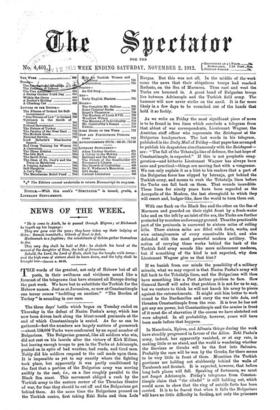The three days' battle which began on Tuesday ended on
Thursday in the defeat of Nazim Pasha's army, which has now been driven back along the blunt-nosed peninsula at the end of which Constantinople is seated. As far as can be gathered—but the numbers are largely matters of guesswork —about 150,000 Turks were confronted by an equal number of Bulgarians. The Bulgarian general, like all soldiers who win, did not rest on his laurels after the victory of Kirk Kilisse, but leaving enough troops to pen in the Turks at Adrianople, pushed on in spite of bad weather, bad roads, and tired men. Nobly did his soldiers respond to the call made upon them. It is impossible as yet to say exactly where the fighting took place, but apparently it was partly conditioned by the fact that a portion of the Bulgarian army was moving swiftly to the east, i.e., on a line roughly parallel to the Black Sea coast. This movement obliged a rush by the Turkish army to the eastern corner of the Thracian theatre of war, for fear they should be cut off and the Bulgarians get behind them. At the same time the Bulgarians pressed on the Turkish centre, first taking Eski Baba and then Lule Burgas. But this was not all. In the middle of the week came the news that their ubiquitous troops had reached Rodosto, on the Sea of Marmora. Thus east and west the Turks are hemmed in. A great band of Bulgarian troops lies between Adrianople and the Turkish field army. The hammer will now never strike on the anvil. It is far more likely in a few days to be wrenched out of the hands that hold it so feebly.


























































 Previous page
Previous page